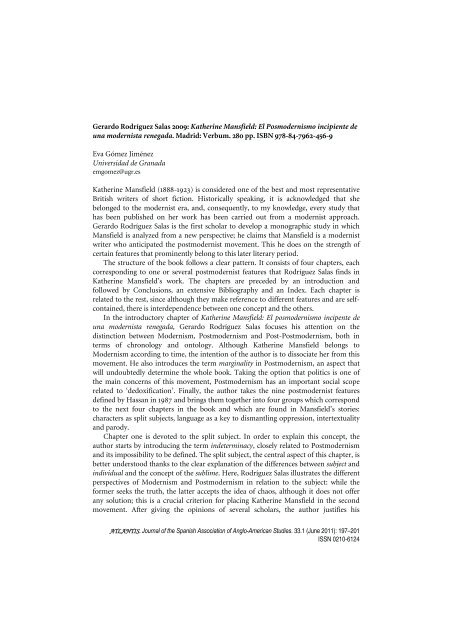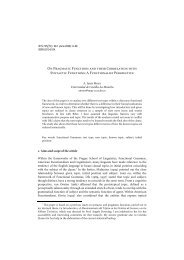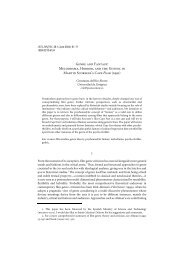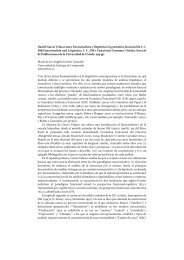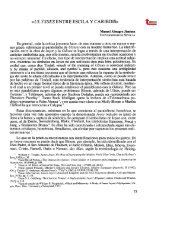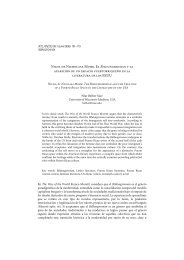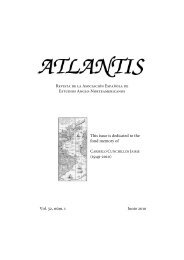Gerardo Rodríguez Salas 2009: Katherine Mansfield: El ... - Atlantis
Gerardo Rodríguez Salas 2009: Katherine Mansfield: El ... - Atlantis
Gerardo Rodríguez Salas 2009: Katherine Mansfield: El ... - Atlantis
Create successful ePaper yourself
Turn your PDF publications into a flip-book with our unique Google optimized e-Paper software.
<strong>Gerardo</strong> <strong>Rodríguez</strong> <strong>Salas</strong> <strong>2009</strong>: <strong>Katherine</strong> <strong>Mansfield</strong>: <strong>El</strong> Posmodernismo incipiente de<br />
una modernista renegada. Madrid: Verbum. 280 pp. ISBN 978-84-7962-456-9<br />
Eva Gómez Jiménez<br />
Universidad de Granada<br />
emgomez@ugr.es<br />
<strong>Katherine</strong> <strong>Mansfield</strong> (1888-1923) is considered one of the best and most representative<br />
British writers of short fiction. Historically speaking, it is acknowledged that she<br />
belonged to the modernist era, and, consequently, to my knowledge, every study that<br />
has been published on her work has been carried out from a modernist approach.<br />
<strong>Gerardo</strong> <strong>Rodríguez</strong> <strong>Salas</strong> is the first scholar to develop a monographic study in which<br />
<strong>Mansfield</strong> is analyzed from a new perspective; he claims that <strong>Mansfield</strong> is a modernist<br />
writer who anticipated the postmodernist movement. This he does on the strength of<br />
certain features that prominently belong to this later literary period.<br />
The structure of the book follows a clear pattern. It consists of four chapters, each<br />
corresponding to one or several postmodernist features that <strong>Rodríguez</strong> <strong>Salas</strong> finds in<br />
<strong>Katherine</strong> <strong>Mansfield</strong>’s work. The chapters are preceded by an introduction and<br />
followed by Conclusions, an extensive Bibliography and an Index. Each chapter is<br />
related to the rest, since although they make reference to different features and are selfcontained,<br />
there is interdependence between one concept and the others.<br />
In the introductory chapter of <strong>Katherine</strong> <strong>Mansfield</strong>: <strong>El</strong> posmodernismo incipente de<br />
una modernista renegada, <strong>Gerardo</strong> <strong>Rodríguez</strong> <strong>Salas</strong> focuses his attention on the<br />
distinction between Modernism, Postmodernism and Post-Postmodernism, both in<br />
terms of chronology and ontology. Although <strong>Katherine</strong> <strong>Mansfield</strong> belongs to<br />
Modernism according to time, the intention of the author is to dissociate her from this<br />
movement. He also introduces the term marginality in Postmodernism, an aspect that<br />
will undoubtedly determine the whole book. Taking the option that politics is one of<br />
the main concerns of this movement, Postmodernism has an important social scope<br />
related to ‘dedoxification’. Finally, the author takes the nine postmodernist features<br />
defined by Hassan in 1987 and brings them together into four groups which correspond<br />
to the next four chapters in the book and which are found in <strong>Mansfield</strong>’s stories:<br />
characters as split subjects, language as a key to dismantling oppression, intertextuality<br />
and parody.<br />
Chapter one is devoted to the split subject. In order to explain this concept, the<br />
author starts by introducing the term indeterminacy, closely related to Postmodernism<br />
and its impossibility to be defined. The split subject, the central aspect of this chapter, is<br />
better understood thanks to the clear explanation of the differences between subject and<br />
individual and the concept of the sublime. Here, <strong>Rodríguez</strong> <strong>Salas</strong> illustrates the different<br />
perspectives of Modernism and Postmodernism in relation to the subject: while the<br />
former seeks the truth, the latter accepts the idea of chaos, although it does not offer<br />
any solution; this is a crucial criterion for placing <strong>Katherine</strong> <strong>Mansfield</strong> in the second<br />
movement. After giving the opinions of several scholars, the author justifies his<br />
ATLANTIS. Journal of the Spanish Association of Anglo-American Studies. 33.1 (June 2011): 197–201<br />
ISSN 0210-6124
198 Eva Gómez Jiménez<br />
preference for Wilde’s theory (1981). Finally, <strong>Rodríguez</strong> <strong>Salas</strong> explains the three<br />
attitudes towards essence in Postmodernism: apocalypse, optimism and conciliation.<br />
He adopts a conciliatory position, suggesting a fragmented, split subject whose inner<br />
world is always an interrogation. This first part of the chapter provides the theoretical<br />
background, in places somewhat densely, that underpins the thesis proposed<br />
throughout this book. Subsequently, he applies this theoretical background to<br />
<strong>Mansfield</strong>’s texts. Starting with the autobiographical material, the author shows that,<br />
while the letters give an optimistic vision (they show the social projection of the<br />
subject), the diary is the perfect example of the conciliatory position (<strong>Mansfield</strong> uses<br />
this material to defend artificiality and fragmentation, and admits the concept of the<br />
sublime).The textual analysis involving ‘The Daughters of the Late Colonel’, ‘The<br />
Garden Party’, ‘Je ne parle pas français’ and ‘A Married Man’s Story’ provides many<br />
examples to justify the author’s position.<br />
Chapter two, ‘Lenguaje, dogmatismo y estrategias subversivas’, is similar in<br />
structure. It starts by presenting language as a powerful tool for society, together with<br />
the concept of mask. This part calls attention to ideology, the concept of catachresis,<br />
denotation and pronouns, while also introducing silence and paraliterature. In this way,<br />
<strong>Rodríguez</strong> <strong>Salas</strong> attempts to define <strong>Katherine</strong> <strong>Mansfield</strong>’s type of metafiction and her<br />
use of silence and paraliterature as subversive strategies, although the latter is not used<br />
as an incipient feature of her work. As regards silence, <strong>Rodríguez</strong> <strong>Salas</strong> analyses ‘Weak<br />
Heart’, ‘The Doll’s House’, ‘The Daughters of the Late Colonel’ and ‘The Garden Party’:<br />
in all of them, the position of <strong>Katherine</strong> <strong>Mansfield</strong> towards silence is systematized and<br />
there are two levels of significance, which <strong>Rodríguez</strong> <strong>Salas</strong> justifies with a profusion of<br />
examples. Regarding paraliterature, having analysed ‘Miss Brill’, ‘Je ne parle pas français’<br />
and ‘A Married Man’s Story’, <strong>Rodríguez</strong> <strong>Salas</strong> finds common features, such as the<br />
references to theatre, the artificiality of language, or even the consciousness of the<br />
literary process.<br />
Chapter three is the longest, and also the one which contains a deeper textual<br />
analysis. This section focuses on intertextuality and, just as in the previous chapters, the<br />
author starts by clarifying the meaning of this term, stating the relation between it and<br />
paraliterature. For the sake of better understanding, the author selects Genette (1989)<br />
and Bakhtin (1994), taking from the first one the clarification of the main concept as<br />
the relation of coexistence between two or more texts. The relevant aspect in Bakhtin is<br />
the ‘ludicrous’, an aspect that, according to the author, is always present in <strong>Mansfield</strong>’s<br />
production. As Bakhtin points out, there is a clear union between the former and<br />
Postmodernism, for both are subordinated to the dominant canon. As before, the<br />
remarkable point of this section is the presence of clear explanations of all the terms<br />
that are to be used in the textual analysis, for example, dialogism, polyphony,<br />
heteroglossia, or the role of the reader. Once everything has been explained, fairytales are<br />
selected by the author to represent this postmodernist feature in <strong>Mansfield</strong>. <strong>Rodríguez</strong><br />
<strong>Salas</strong> then proceeds to focus his attention on the conscious use of intertextuality made<br />
by <strong>Mansfield</strong>. He completes his theoretical frame by citing Propp’s Morphology of the<br />
Folktale (1985) as the starting point for the deepest textual analysis in the book. This<br />
analysis distinguishes the early fairytales from those written in adulthood. The first,<br />
written when <strong>Mansfield</strong> was a teenager, follow the traditional fairytale structure,<br />
ATLANTIS. Journal of the Spanish Association of Anglo-American Studies. 33.1 (June 2011): 197–201<br />
ISSN 0210-6124
Reviews 199<br />
although, as <strong>Rodríguez</strong> <strong>Salas</strong> emphasises, their themes are usually those of death,<br />
darkness or sex. ‘In Summer’, ‘A Fairy Tale’, ‘The Green Tree: A Fairy Tale’, ‘His Ideal’<br />
and ‘Les deux étrangères’ are the analyzed texts. The author reveals their structure<br />
according to Propp’s theory, and draws our attention to those elements that make these<br />
intentionally subversive. <strong>Katherine</strong> <strong>Mansfield</strong> uses the structure of the classic fairy tale<br />
in order to question the dominant social values, though in most we can infer a magical<br />
atmosphere. Things become different in <strong>Mansfield</strong>’s fairytales about adulthood:<br />
realism, the absence of a magic element, a modernist approach and a new treatment for<br />
the themes that were already used before are the features of these texts. <strong>Rodríguez</strong> <strong>Salas</strong><br />
discusses intertextuality in ‘Sun and Moon’, ‘A Suburban Fairy Tale’ and ‘The Tiredness<br />
of Rosabel’, in particular the influence of ‘Hansel and Gretel’, ‘The Bible’ or<br />
‘Cinderella’.<br />
The last chapter in the book is devoted to irony, parody and pastiche. Here again,<br />
<strong>Rodríguez</strong> <strong>Salas</strong> starts the section by explaining the differences between these three<br />
subversive strategies and their relation to paraliterature and intertextuality. His<br />
intention is to clarify the situation of irony in Postmodernism, since traditionally it has<br />
been placed as a typical feature in Modernism. Different types of irony are also used to<br />
distinguish this aspect. Subsequently, he summarises the debate for parody and its<br />
comic effect, ending this first section by distinguishing the differences between both<br />
concepts. Textual analysis in this last chapter is exemplified, in this case, in ‘Taking the<br />
Veil’, ‘Violet’ and ‘Picture’. The sentimental novel and <strong>Katherine</strong> <strong>Mansfield</strong>’s inversion<br />
of its features are the central elements of this analysis. <strong>Rodríguez</strong> <strong>Salas</strong> explains how the<br />
author uses such features as women’s passivity, sentimentality or extreme passion in<br />
order to show how we should infer the need for change in society. Irony, of course, is<br />
<strong>Mansfield</strong>’s tool; immaturity and sacrifice are the result of women’s reading sentimental<br />
novels. A summary of the structure important aspects of the chapters serves as a<br />
conclusion and justification of <strong>Salas</strong>’ postmodernist claim, defending the constant idea<br />
that she anticipated this new movement.<br />
<strong>Rodríguez</strong> <strong>Salas</strong> offers in this book a consistent, clear account of bibliographical<br />
references on <strong>Mansfield</strong> and Postmodernism. “[w]hat we need to develop now with<br />
<strong>Mansfield</strong> criticism and scholarship is what might be called a postmodern view”<br />
(Morrow 1990: 42). This statement encapsulates the starting point of this study, and<br />
transforms this book into the first volume that defines <strong>Mansfield</strong>’s works by means of a<br />
new critical perspective. At the same time he makes use of the recent modernist<br />
approaches that were developed, providing the reader with an excellent, recent<br />
bibliographical background.<br />
Theoretically speaking, the book by <strong>Rodríguez</strong> <strong>Salas</strong> is deep and clarifying. Almost<br />
the same length is devoted to theoretical discussion as to textual analysis. This is<br />
helpful, since it provides a complete framework for readers to understand the author’s<br />
analysis. The length of the book also helps to deal with the matter in depth, which can<br />
be increased if the other monographic study, Hijas de la diosa Blanca: ginocrítica y<br />
feminismo restaurador en la narrative de <strong>Katherine</strong> <strong>Mansfield</strong> (2007), is taken in<br />
consideration.<br />
Leaving aside critical aspects, <strong>Katherine</strong> <strong>Mansfield</strong>: <strong>El</strong> posmodernismo incipiente de<br />
una modernista renegada is a well-structured book. An important aspect of the study is<br />
ATLANTIS. Journal of the Spanish Association of Anglo-American Studies. 33.1 (June 2011): 197–201<br />
ISSN 0210-6124
200 Eva Gómez Jiménez<br />
its simplicity in structure, since every chapter is divided into two main parts: the theory<br />
and the analysis, thus enabling readers to find their way around when seeking a certain<br />
part. The length of the Index likewise contributes to the facility in locating discussions<br />
or analysis of the short stories. Footnotes have been judiciously employed by <strong>Rodríguez</strong><br />
<strong>Salas</strong> to clarify certain sections, a feature for which readers will be grateful since<br />
footnotes are much more manageable than endnotes.<br />
My only concern about this book is the absence of references to other studies and<br />
publications related to <strong>Mansfield</strong>. Apart from a brief mention of Patrick D. Morrow’s<br />
four-page piece of 1990, which points to the absence of a monographic study of<br />
<strong>Mansfield</strong> in terms of Postmodernism, there is nothing of relevance.<br />
It is true that <strong>Rodríguez</strong> <strong>Salas</strong> initiates his introduction by citing certain names and<br />
perspectives apart from his own, and throughout the whole book he makes reference to<br />
many scholars. Nevertheless, the volume does not offer the possibility for the reader to<br />
know the content of these other works in relation to that of the author. It would have<br />
been of great interest to readers if the author had included and discussed these<br />
publications, enabling the reader to form a balanced comprehension of <strong>Rodríguez</strong><br />
<strong>Salas</strong>’ contribution to the subject of <strong>Katherine</strong> <strong>Mansfield</strong>’s oeuvre.<br />
In this sense, it is surprising that, apart from <strong>Rodríguez</strong> <strong>Salas</strong>’ dissertation, in Spain<br />
there is only one thesis on <strong>Katherine</strong> <strong>Mansfield</strong>, Recurrencias temáticas y formales en el<br />
cuento de autoras en lengua inglesa: de <strong>Mansfield</strong> a Carter, by Maria Isabel Carrera<br />
Suárez, defended in 1988. The subject of this thesis is unrelated to that of <strong>Rodríguez</strong><br />
<strong>Salas</strong>, and furthermore, does not deal exclusively with <strong>Mansfield</strong>. Outside Spain, there<br />
are a number of dissertations that also deal with this author with regard to feminism,<br />
but none studies <strong>Mansfield</strong> from a postmodernist perspective. At the same time, the<br />
number of theses on <strong>Mansfield</strong> in the last decade is very low. The effort carried out by<br />
<strong>Rodríguez</strong> <strong>Salas</strong> has the merit of producing a work that is innovative, exhaustive and<br />
pioneering. <strong>Rodríguez</strong> <strong>Salas</strong> undoubtedly contributes to clarifying understanding of<br />
<strong>Mansfield</strong>, and his book can be compared to neither contemporary nor previous<br />
studies. In this respect its contribution to this field is essential reading.<br />
This reviewer sees it as a work that will not disappoint and will, on the contrary,<br />
provide a stimulus to re-read <strong>Mansfield</strong>’s short stories, this time from a postmodern<br />
perspective.<br />
Works Cited<br />
Bakhtin, Mijaíl Mijáilovich 1981 (1965): ‘From M. M. Bakhtin, Rabelais and His World, 1965’.<br />
Pam Morris, ed. Trans. H. Iswolsky. London and New York: Edward Arnold. 89-96.<br />
Carrera Suárez, Maria Isabel 1988. Recurrencias temáticas y formales en el cuento de autoras en<br />
lengua inglesa: de <strong>Mansfield</strong> a Carter. Unpublished Ph. D. thesis. Universidad de Oviedo,<br />
Spain.<br />
Genette, Gerard 1989 (1962): Palimpsestos: La literatura en segundo grado. Trans. Celia Fernández<br />
Prieto. Madrid: Altea, Taurus, Alfaguara.<br />
Hassan, Ihab 1987: The Postmodern Turn: Essays in Postmodern Theory and Culture. Ohio: Ohio<br />
State UP.<br />
Jameson, Fredrick 1984: Introduction. The Postmodern Condition: A Report on Knowledge. Trans.<br />
Geoff Bennington and Brian Massumi. Manchester: Manchester UP.<br />
ATLANTIS. Journal of the Spanish Association of Anglo-American Studies. 33.1 (June 2011): 197–201<br />
ISSN 0210-6124
Reviews 201<br />
Morrow, Patrick D. 1990: ‘<strong>Katherine</strong> <strong>Mansfield</strong> and World War I’. David Bevan, ed. Literature<br />
and War. Amsterdam and Atlanta. 39-43.<br />
Propp, Vladimir 1985 (1929): Morfología del cuento. Trans. F. Díez del Corral. Madrid: Akal.<br />
<strong>Rodríguez</strong> <strong>Salas</strong>, <strong>Gerardo</strong> 2003: La marginalidad como opción en <strong>Katherine</strong> <strong>Mansfield</strong>:<br />
postmodernismo, feminismo y relato corto. Unpublished Ph. D. thesis. Universidad de<br />
Granada, Spain.<br />
<strong>Rodríguez</strong> <strong>Salas</strong>, <strong>Gerardo</strong> 2007: Hijas de la diosa Blanca: ginocrítica y feminismo restaurador en la<br />
narrativa de <strong>Katherine</strong> <strong>Mansfield</strong>. Oviedo: Septem.<br />
Wilde, Alan 1981: Horizons of Assent: Modernism, Postmodernism, and the Ironic Imagination.<br />
Baltimore and London: The John Hopkins UP.<br />
Received 7 January 2011 Revised version accepted 9 April 2011<br />
Eva María Gómez Jíménez (MPhil Granada) is a postgraduate researcher at the University of Granada.<br />
Her research interests centre on e.e.cummings, Modernism, experimental poetry and translation studies.<br />
Address: Departamento de Filología Inglesa y Alemana, Universidad de Granada, Campus de Cartuja s/n<br />
18071 Granada, Spain. Tel.: +34 958243677. Fax: +34958243678.<br />
ATLANTIS. Journal of the Spanish Association of Anglo-American Studies. 33.1 (June 2011): 197–201<br />
ISSN 0210-6124


